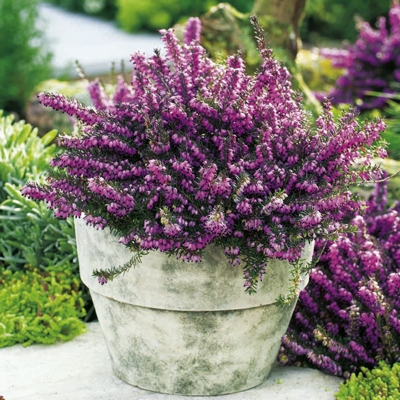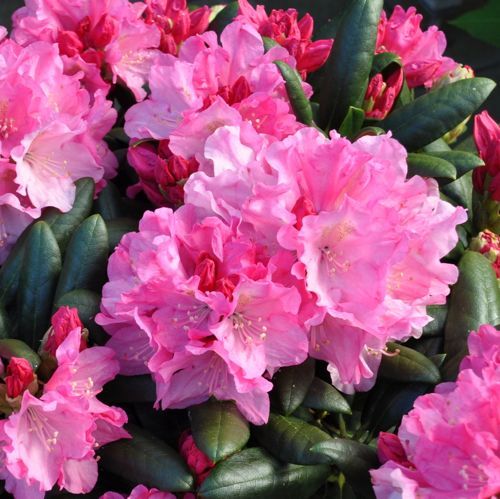
Ericaceous Compost
Ericaceous Compost can seem difficult to understand and adds to things to worry about. It really shouldn't and this article will help to get your head round what Ericaceous Compost is and what Ericacous Compost is used for.
What is Ericaceous Compost

You will probably have heard of ericaceous compost in terms of what you can grow in it. It is an acidic compost, and suitable for growing rhododendrons, camellias, azaleas, heathers, and other plants that dislike alkaline soil, also known as lime-hating plants. The name ‘ericaceous’ comes from the Latin name for heathers, Erica.
Our ericaceous compost has a pH balance which is perfect for growing acid loving plants including blueberries, azaleas, camellias, rhododendrons, and heathers. The increasing popularity of blueberry bushes in our gardens and tomatoes in our greenhouses have made this one of the most widely-used and trusted specialist composts on the market. Whether it’s juicy superfoods or the vibrant, striking colour of acer trees, the delicate beauty of camellias, or the hardy, year-round charm of checkerberry, Ericaceous soil improvers offer your garden a healthy dose of low-ph goodness to keep your favourite specimens thriving. Specially formulated to provide a balanced nutritional profile for acid-loving plants, our Ericaceous compost is a great way to compensate for alkaline soil conditions to benefit your plants, while also feeding and nurturing them, regulating moisture and providing effective top dressing.
Ericaceous compost is trusted by experienced gardeners across the country to boost soil’s ph. profile, and keep acid-loving plants thriving!
Summary Of Ericaceous Compost Facts

Ericaceous plants needs to live in the correct soil for their vitamin needs- while lime-rich, high pH (alkaline) soil tends to bind the iron and other nutrients essential for healthy growth. Plants that need nutrients which are inaccessible in high pH soil are known as acid-loving (or lime-hating). If planted in normal, limey or alkaline soil,Ericaceous plants produce weak, yellow leaves and generally perform poorly.
Learn more about soil pH here and here.
Ensuring your Ericaceous plants perform well can be a challenge in the wrong soil. While long-term changes to neutralise alkalinity are possible, most gardening experts recommend planting your Ericaceous plants in an isolated pocket of acidic soil, using high quality topsoil and compost designed especially for this role. With the right specialist soil & compost, even the most demanding Ericaceous plants can thrive.
There are several ways to test your soil pH- for the most reliable results we recommend using a specialist kit.
We only stock Ericaceous Compost from reliable, tried & tested suppliers- and all our stock has been thoroughly tested on our own farm! We won’t sell a blend until it’s impressed us- and we’re satisfied its production surpasses high ethical standards.
Ericaceous compost gets amazing results because it allows the release of those vitamins, such as iron, needed most by acid-loving plants. These essential vitamins can be bound up in the structure of normal soil, depriving the roots of your plants and resulting in stunted, unhealthy growth that can leave you exasperated.
When should You Use Acidic Compost?
You use ericaceous compost when the soil in your garden is too alkaline to grow lime-haters. And how do you know the pH of your soil? Well, you can either look at your neighbours’ gardens to see if they’re growing rhododendrons, or you can buy a soil-testing kit and test the pH for yourself. If the pH is above 7.0, then you will probably need to grow your ericaceous plants in pots, and in ericaceous compost. Although you can add chemicals to increase the acidity of your soil, you probably won’t have much long-term effect, especially if your soil is very alkaline. And some plants are so strongly ericaceous that they won’t grow in even slightly alkaline soil. Rhododendrons and azaleas are more tolerant, but blueberries like a pH of less than 5.5, so need to be grown in pots in ericaceous compost in much of the UK.
Where Can I Buy Ericaceous Compost?
Ericaceous compost is widely available from garden centres and compost suppliers. The Royal Horticultural Society recommends loam-based ericaceous compost such as John Innes Compost, but says that peat-free ericaceous composts are improving all the time, and will be perfectly suitable.
You can grow a wide range of plants in pots, even quite large shrubs such as camellias, provided you choose the right pots. Dwarf rhododendrons, such as the Rhododendron yakushimanum hybrids, are really good pot plants. They flower reliably, year after year, and remain small. There are also some lovely dwarf azaleas available that are perfect for pot cultivation. Camellias can get a bit big, but choose carefully, and you could even have one of those. As with all pot cultivation, you need to choose a pot that is not too much bigger than the pot your plant is currently in, or the soil will go sour before the roots have spread into it. You need it to be about two inches bigger than the rootball all the way round. If you want to use a much bigger pot, then put several plants in it.
Whatever ericaceous compost you choose, your plants will need repotting every couple of years, as the compost will lose its structure and nutrients over time. This will give you a chance to move your plants into bigger pots if necessary, or prune the rootball if you want to keep them small. Your plants will also thank you for feeding them with ericaceous fertiliser in the spring when they start to grow again.
Ericaceous Compost Uses
Ericaceous compost is used for a lot of different purposes. Here is a small list of uses, with links to the RHS' website for more information on each suggestion:
- Azaleas - a charming rhododendron flower with a bright and summery feel, great for brightening up your garden in those summer months. Read more on RHS
- Blueberries - delicious (and very healthy!) treats with a delicate taste, perfect for baking, desserts or smoothies. For more information check out our article on blueberries! Read more on RHS
- Raspberries - pretty and, of course, delicious! Like most berries these produce a huge crop that can be eaten as sweet summer desserts, made into jam, or frozen. Read more on RHS
- Parsley - this traditional and versatile herb offers a welcome, fresh, peppery taste to any meal. Read more on RHS
- Camellias - stunning flowers with a range of soft colours matched only by their elegant, almost porcelain beauty. Read more on RHS
- Tomatoes - homegrown, freshly plucked from the vine: you’ll never get them of the supermarket again. The sweet, fresh slightly bitter scent of those soft pine green vines is enchanting. Read more on RHS
- Callunas (heather) - Whether you want give your garden a wild feel, or simply punctuate your borders with a perennial flash of colour, these hardy plants offer a wide range of award-winning flowers. Read more on RHS
- Enkianthus - gorgeous drops of colour that give your garden an Eastern feel. A beautiful shrub that not only supports stunning summer flowers but also produces an amazing variety of browns, reds and yellows in Autumn. Read more on RHS
- Kalmias - Striking flowers originally from America, the popular Latifolia variety especially produces amazing ring-style colourations with shocking contrasts that really liven up a garden.Read more on RHS
- Pieris - also known as forest flame, this often-overlooked shrub, if properly cared for, can develop into an elegant but hardy feature in your garden, decked in a subtle red-yellow leaves. Read more on RHS
- Rhubarb - Massive and unmissable, rhubarb is also a great source of vitamin-rich, tart stalks.